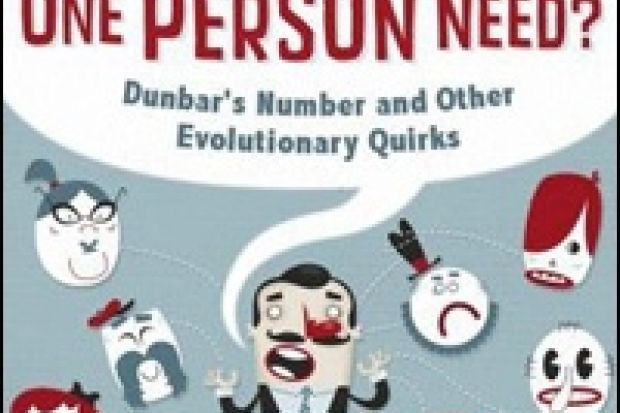Do you believe that Barack Obama was elected President of the US in preference to John McCain because he was taller, and had a more symmetrical face? If so, you are likely to enjoy evolutionary anthropologist Robin Dunbar's latest essay collection. We are, it seems, evolutionarily programmed to prefer such height and symmetry. Those of us who thought that the election result might have something to do with US voters' repugnance at eight years of George W. Bush, an economic crisis and two dubious wars are clearly naively incapable at looking below the socio-political surface. Yet there's a puzzle here. Preoccupied with explaining the evolutionary psychology of Obama's success, Dunbar fails to wonder how it came about that 40 per cent or so of American citizens chose to deny their evolutionary heritage by voting McCain.
Of course, we humans are who we are as products of 3.5 billion years of evolution of life on earth. But this doesn't mean that we should seek evolutionary explanations for why we do what we do when more straightforward, "proximate" explanations fit the case better. This confusion of anecdote with evidence, and rejection of the proximate in favour of the distal, is typical of Dunbar's approach. The essays in this short book are replete with speculative hypotheses masquerading as established facts. He is - I should say in common with many others who brand themselves evolutionary psychologists - ever willing to generalise out from what he regards as a feature of current Western industrial society and culture towards a claimed human universal, programmed into us by our evolutionary history.
A few examples will suffice. Why do older men in 21st-century EuroAmerica appear to prefer to have sex with younger women of a low waist-hip ratio? Apparently this is because it indicates that their young partners will be fertile - never mind that for most older men seeking such sex, the last thing they may want is to be encumbered with a new baby. But is it a universal evolved phenomenon anyhow? A glance at the Rubens portraits in the National Gallery, or the female Pleistocene figurines with their emphasis on plump bodies, would suggest otherwise. When fertility was most likely to be at a premium, Pleistocene men clearly had different priorities.
Why do men have serious conversations about plans and gadgets, while women gossip? Gossip is, it appears, an evolved form of the grooming activities of our ape cousins. And because men are busy being hunters, they need to leave it to the women to provide the social glue to hold a group together. So male pub football chat isn't gossip? And how much gossip do women have time for as they enter what were hitherto male occupational preserves?
Of course there are some interesting nuggets buried within the essays (along with some gratuitous errors of fact - Dunbar says gene when he means DNA, and speaks of the cognitive left brain versus the emotional right brain as if this were neuroscience, not a 30-year-old metaphor). But there's also political naivety, as when he calls for the abolition of trial by randomly selected jury (who have "stone-age brains") to be replaced by a professionally qualified team of jurors. However, that loses the point of being tried by one's peers, and the responsibility of one's fellow citizens in helping judge guilt or innocence.
So what might Dunbar's number be? Well, it refers to the number of friends we are evolutionarily predisposed to want or need. Fine; this is a topic that social anthropologists have explored over many years. According to Dunbar, it is dependent on the size of our neocortex, a recently evolved brain region particularly large in humans. But what might the magic number be? Well, it might be three. Or 12. Or 30. Or 150. Or indeed 1,500. Or, I suppose, any number in between. And to judge by the number of unwanted invitations that appear in my email in-box inviting me to sign up to Facebook or Twitter and become a "friend" to someone I have never heard of, numbers are set to increase exponentially with new technology.
These and similar ideas fill many of Dunbar's 22 chapters. The majority first appeared either in New Scientist or The Scotsman. Such popular science writing has a long and glorious tradition from Thomas Huxley in the 19th century through J.B.S. Haldane in the 1930s to, most recently, the late and much-lamented Stephen Jay Gould. But Dunbar's style often has more in common with the pub autodidact than these illustrious predecessors. There's a slightly smutty, all-boys-together feel about the writing that would make me long for Haldane's austerity, even were I not so under-convinced by the argument.
Entertaining they may be, but I wouldn't recommend taking many of these just-so stories as either evolutionary or social gospel.
How Many Friends Does One Person Need? Dunbar's Number and Other Evolutionary Quirks
By Robin Dunbar Faber and Faber, 320pp, £14.99
ISBN 9780571253425
Published 4 February 2010
Register to continue
Why register?
- Registration is free and only takes a moment
- Once registered, you can read 3 articles a month
- Sign up for our newsletter
Subscribe
Or subscribe for unlimited access to:
- Unlimited access to news, views, insights & reviews
- Digital editions
- Digital access to THE’s university and college rankings analysis
Already registered or a current subscriber? Login
